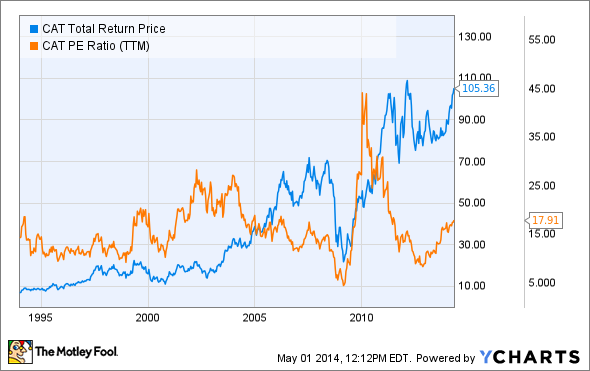The Dow Jones Industrial Average (^DJI 0.51%) finally set a new all-time high yesterday by closing at 16,580.84 points -- four points higher than, and 81 days after, the old record set on the last day of 2013. Some components (many in the financial sector) have weighed on the index all year, preventing it from setting a new record earlier, but there are four Dow stocks that have clearly been standing between it and a worse performance in 2014:
CAT Total Return Price data by YCharts.
No other Dow component has so much as cleared a 5% gain for the year to date, but Caterpillar (CAT 1.61%), Merck (MRK -0.36%), Johnson & Johnson (JNJ 1.37%) and Microsoft (MSFT 0.26%) have been shining stars, relatively speaking. Due to the way the Dow works, Caterpillar has been the single most important stock of this foursome -- its higher-priced shares are worth 4.1% of the Dow's daily movements, compared to weightings of 2.3% for Merck, 3.9% for Johnson & Johnson, and a mere 1.6% for Microsoft.
So what has propelled these four shares higher than their Dow peers this year?
Microsoft's first four months in review
There are a few reasons why Microsoft is rewarding shareholders recently after a long stretch of mediocrity. For one, analysts and investors may simply be resetting their expectations for the world's largest software company, which has lately seen its bottom line flatten after years of solid growth:
MSFT Total Return Price data by YCharts.
Since the start of 2012, Microsoft's shares have gained roughly 45%, and its valuation has also grown by nearly the same amount -- the company's P/E ratio had barely been in double-digit territory before then, but investors have flocked to Microsoft just as its business hit a growth wall.
Another reason for optimism is the appointment of new CEO Satya Nadella, who appears set to shake up Microsoft's outdated -- and frequently combative -- corporate culture. Nadella is only the third CEO in Microsoft's nearly 40-year history, but he'll need to bring a fresh perspective to the corner office to revitalize a company that appears directionless in the post-PC age. Many industry-watchers believe he's got the chops to pull it off, but only time will tell.
Merck's first four months in review
Like all massive drugmakers, Merck's future hinges on the development of new blockbusters to replace those about to fall off the patent cliff. Fool writer Peter Stephens highlights several potential breakthroughs now in trials at Merck's labs, but most appear set for fierce competition in the increasingly cutthroat world of Big Pharma. Merck is also making waves by exploring the potential sale of its smaller and less-lucrative consumer-care segment, which could bring in more than $10 billion in cash and help the company refocus on profitable drug development. The company doesn't exactly need more cash right now, as it's got a veritable printing press these days:
MRK Total Return Price data by YCharts.
Merck generated over $10 billion in free cash flow for 2013, even though its earnings have fallen substantially in recent years. Investors don't seem to mind Merck's shriveling earnings per share or its flattish free cash flow -- the former has declined 30% since 2011, and Merck's trailing 12-month free cash flow is 5% below its level at the end of that year. Merck's strong dividend doesn't hurt its appeal, but years of share-price appreciation have pushed it down to 11th place on the Dow's dividend-yield rankings. Maybe optimism has gotten ahead of itself here?
Johnson & Johnson's first four months in review
The two health-care stocks on this list share the sales rights for the world's second-best-selling drug, Remicade, but Johnson & Johnson has more going for it. The company's pharmaceutical segment posted 11% year-over-year sales growth in 2013, and there are other potential blockbusters in the wings, including diabetes drug Invokana. Unlike the first two companies on our list, Johnson & Johnson's recent growth has been largely driven by fundamental improvements -- earnings per share have grown nearly in line with its share price since the start of 2012:
JNJ Total Return Price data by YCharts.
Johnson & Johnson's surprisingly deep lineup of prescription drugs should keep its growth going through 2014, which might make the company's gains to date this year more supportable than its peers on this list.
Caterpillar's first four months in review
Caterpillar's gains are stranger than most, as its shares traded effectively flat for most of 2013 before taking off on a nearly uninterrupted ride higher shortly before the start of the year. There's not much fundamental reason why this should be happening, as Caterpillar's share-price gains have come despite a big drop in earnings during that time:
CAT Total Return Price data by YCharts.
So what's going on here? If you're a value investor, the answer might be easy enough to see -- the last time Caterpillar's shares were as cheap on valuation as they were in 2013 was at the start of the financial crisis. In fact, 2013 saw the cheapest (barring financial-crisis drops) Caterpillar shares of the past 20 years, valuation-wise:
CAT Total Return Price data by YCharts.
Caterpillar's business landscape doesn't look pretty for the time being, but the company is working hard to cut costs and improve on its strengths in mining and construction so that things never turn too bleak. However, the fact that its growth has been more than 100% valuation-based (since earnings have declined, its P/E has grown faster than its share price) should give investors pause today. The company's free cash flow is strong at the moment, but this metric has been far more volatile as the company responds to the peaks and valleys of equipment demand.











